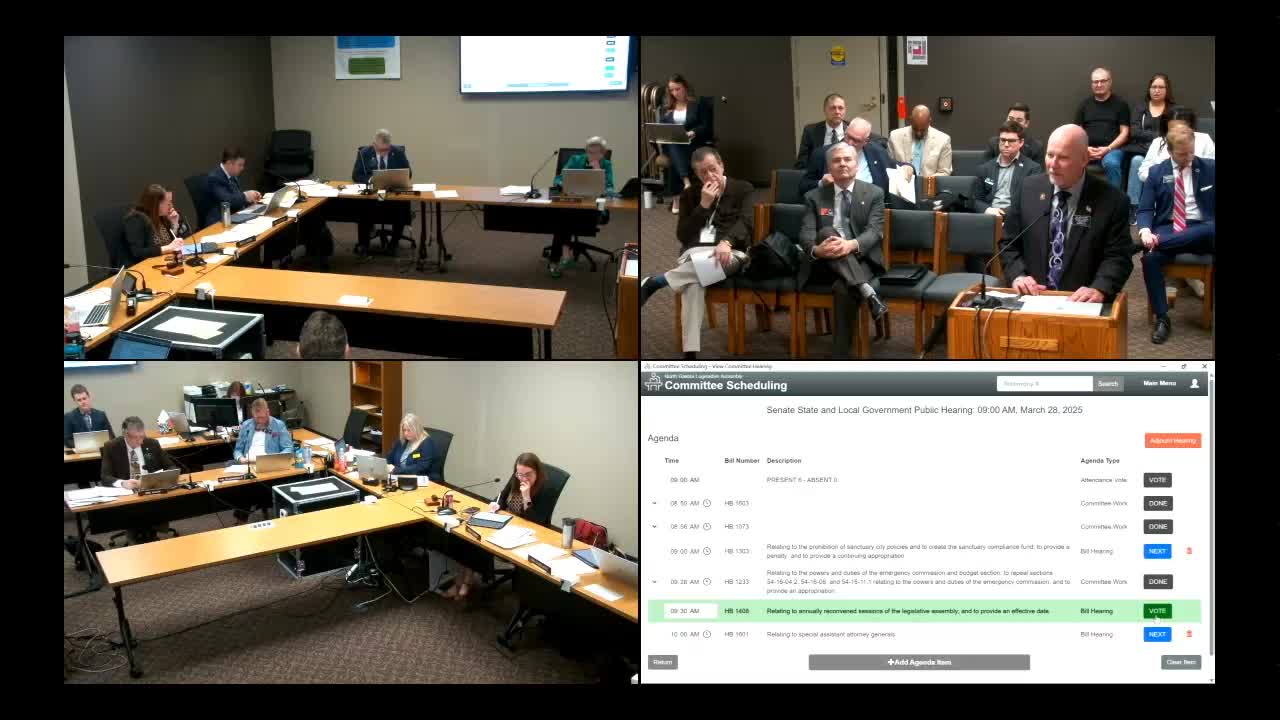South Dakota Council outlines key points for upcoming legislative session
March 28, 2025 | State and Local Government, Senate, Legislative, North Dakota
This article was created by AI summarizing key points discussed. AI makes mistakes, so for full details and context, please refer to the video of the full meeting. Please report any errors so we can fix them. Report an error »

The North Dakota State Legislature convened on March 28, 2025, to discuss the legislative calendar and the implications of proposed changes to the session structure. A key focus of the meeting was the current biennial session system, which has been a longstanding practice in the state.
During the session, legislators reviewed the 38-day calendar used for the 100th legislative session, highlighting important dates such as the opening day, committee assignments, and deadlines for bill introductions. The calendar is designed to ensure that all bills receive both a hearing and a floor vote, a practice that sets North Dakota apart from many other states.
One significant discussion point was the ongoing debate about transitioning to an annual legislative session. Opponents of this change, including representatives from the North Dakota Farm Bureau, voiced concerns about the potential for increased budgets and less effective governance. They argued that the current biennial system allows for thorough vetting of legislation and ensures that all voices are heard, regardless of the popularity of the ideas presented.
The meeting also touched on procedural aspects of the legislative process, including the timeline for bill introductions and the role of committees in shaping legislation. Legislators emphasized the importance of maintaining a structured approach to ensure efficient operations within the limited session days.
As the session progresses, the legislature will continue to address various bills and resolutions, with a total of 498 pieces of legislation already on the table. The discussions from this meeting reflect a commitment to transparency and community engagement, as lawmakers navigate the complexities of governance while considering the needs and concerns of North Dakota residents.
Looking ahead, the legislature will reconvene for the 38th legislative day, where they will further deliberate on the proposed bills and the future of the state's legislative structure. The outcomes of these discussions will have lasting implications for how North Dakota addresses its legislative needs and priorities.
During the session, legislators reviewed the 38-day calendar used for the 100th legislative session, highlighting important dates such as the opening day, committee assignments, and deadlines for bill introductions. The calendar is designed to ensure that all bills receive both a hearing and a floor vote, a practice that sets North Dakota apart from many other states.
One significant discussion point was the ongoing debate about transitioning to an annual legislative session. Opponents of this change, including representatives from the North Dakota Farm Bureau, voiced concerns about the potential for increased budgets and less effective governance. They argued that the current biennial system allows for thorough vetting of legislation and ensures that all voices are heard, regardless of the popularity of the ideas presented.
The meeting also touched on procedural aspects of the legislative process, including the timeline for bill introductions and the role of committees in shaping legislation. Legislators emphasized the importance of maintaining a structured approach to ensure efficient operations within the limited session days.
As the session progresses, the legislature will continue to address various bills and resolutions, with a total of 498 pieces of legislation already on the table. The discussions from this meeting reflect a commitment to transparency and community engagement, as lawmakers navigate the complexities of governance while considering the needs and concerns of North Dakota residents.
Looking ahead, the legislature will reconvene for the 38th legislative day, where they will further deliberate on the proposed bills and the future of the state's legislative structure. The outcomes of these discussions will have lasting implications for how North Dakota addresses its legislative needs and priorities.
View full meeting
This article is based on a recent meeting—watch the full video and explore the complete transcript for deeper insights into the discussion.
View full meeting
